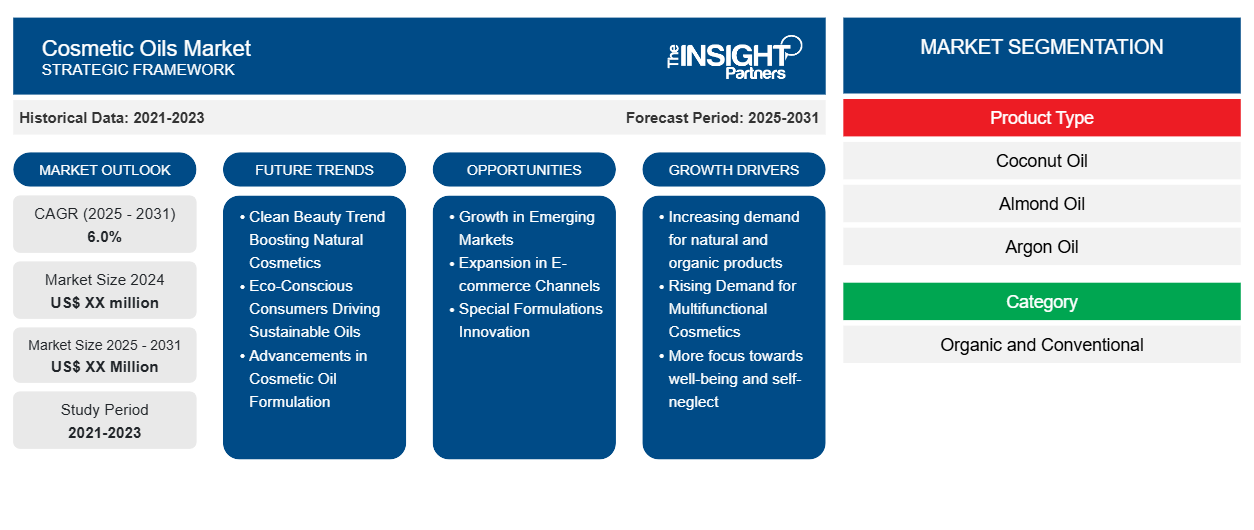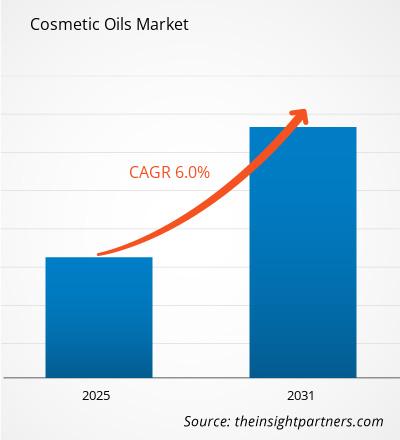The Cosmetic Oils Market is expected to register a CAGR of 6.0% from 2025 to 2031, with a market size expanding from US$ XX million in 2024 to US$ XX Million by 2031.
The cosmetic oils market is segmented into product type, category, distribution channels, and geography. Based on product type, the market is segmented into coconut oil, almond oil, argon oil, tea tree oil, jojoba oil, and others. Based on category, the market is segmented into organic and conventional. Based on distribution channel, the market is segmented into supermarkets and hypermarkets, convenience stores, online retail, and others. The report scope covers five regions: North America, Europe, Asia Pacific, Middle East and Africa, and South and Central America and key countries under each region. The global analysis is further broken down at the regional level and major countries. The Report Offers the Value in USD for the above analysis and segments.
Purpose of the Report
The report Cosmetic Oils Market by The Insight Partners aims to describe the present landscape and future growth, top driving factors, challenges, and opportunities. This will provide insights to various business stakeholders, such as:
- Technology Providers/Manufacturers: To understand the evolving market dynamics and know the potential growth opportunities, enabling them to make informed strategic decisions.
- Investors: To conduct a comprehensive trend analysis regarding the market growth rate, market financial projections, and opportunities that exist across the value chain.
- Regulatory bodies: To regulate policies and police activities in the market with the aim of minimizing abuse, preserving investor trust and confidence, and upholding the integrity and stability of the market.
Cosmetic Oils Market Segmentation
Product Type
- Coconut Oil
- Almond Oil
- Argon Oil
- Tea Tree Oil
- Jojoba Oil
Category
- Organic and Conventional
Distribution Channel
- Supermarkets and Hypermarkets
- Convenience Stores
- Online Retail
Geography
- North America
- Europe
- Asia-Pacific
- South and Central America
- Middle East and Africa
You will get customization on any report - free of charge - including parts of this report, or country-level analysis, Excel Data pack, as well as avail great offers and discounts for start-ups & universities
Cosmetic Oils Market: Strategic Insights

-
Get Top Key Market Trends of this report.This FREE sample will include data analysis, ranging from market trends to estimates and forecasts.
Cosmetic Oils Market Growth Drivers
- Increasing demand for natural and organic products: There is considerable growth in the demand for cosmetics due to growing consumer awareness of the benefits that cosmetics products containing natural and organic ingredients provide. Most consumers today are conscious of the ingredients in their beauty products and look for formulations that are free from harmful chemicals. This has led to a further increase in demand for such natural oils as jojoba, argan, and coconut oil, liked for their nourishing properties and compatibility with skin.
- Rising Demand for Multifunctional Cosmetics: There is an upsurge in the demand for multifunctional cosmetic products as consumers prefer to obtain such products that can do more than one thing. Cosmetic oils also easily fall under this trend since they may be applied to different purposes, including use as a cosmetic for skincare or haircare and even used as makeup. Such versatility makes them highly appealing, hence driving their adoption in a wide range of cosmetic formulations.
- More focus towards well-being and self-neglect: With the increased importance of wellness and selfcare, patterns in consumer choice are slowly being impacted by this trend in the cosmetic industry as well. Consumers do not just want to look good but also feel good. Cosmetic oils, which are considered soothing and therapeutic, would attract the attention of consumers who want to engage in self-care routines.
Cosmetic Oils Market Future Trends
- Clean Beauty Trend Boosting Natural Cosmetics: The clean beauty movement gathered pace and turned out to be a very profitable one where consumers are demanding safety, non-toxicity, and friendliness to the environment in all products used. As a result, brands are much more dependent on natural and organic oils in their formulations and pay even more heed to transparency about sourcing of ingredients. This growing demand for clean beauty forces manufacturers to place a spotlight on the purity and sustainability of their cosmetic oils.
- Eco-Conscious Consumers Driving Sustainable Oils: As more environmentally-conscious consumers increasingly invest in sustainably and ethically sourced cosmetic oils, the brands have to source responsibly to ensure the sustainability of ingredients and benefits toward local communities. This is working fine and is resonating with the eco-conscious consumer; therefore, it is fueling the demand for the kind of products that meet this value as attached to their choices.
- Advancements in Cosmetic Oil Formulation: Cosmetic oils may be capable of extracting and formulating better due to advances in extraction and formulation technology that improve their stability. Techniques like cold pressing and supercritical CO2 extraction allow maximum potency from natural oils. Meanwhile, encapsulation technologies can give further opportunities for manufacturers to enhance the delivery and absorption of actives in oil formulations, further sparking consumer interest.
Cosmetic Oils Market Opportunities
- Growth in Emerging Markets: The emerging market growth opportunities lie in Asian-Pacific, Latin American, and African emerging markets. Higher incomes and their allocations towards disposable income increase urbanization and alter the beauty standards that create a need for cosmetic products, including oils. Brands can now tap into those region-specific products preferred and fit into the culture and preferences of the given region.
- Expansion in E-commerce Channels: This rapid growth in e-commerce creates an excellent scope for cosmetic oil brands to reach out to a larger population. Online acts as a one-stop solution where consumers can view a vast array of products and opt for home delivery. For brands, this can also help invest in digital marketing that could efficiently promote their cosmetic oils by tapping into this growing appetite for online beauty shopping.
- Special Formulations Innovation: There is massive scope for special-purpose formulations in areas related to aging, hydration, and sensitive skin. Brands can use the ability to combine unique blends of oils and active ingredients to create more customized products that relate to specific concerns, which will address a more significant populace of customers and, therefore, strengthen brand affinity.
Cosmetic Oils Market Regional Insights
The regional trends and factors influencing the Cosmetic Oils Market throughout the forecast period have been thoroughly explained by the analysts at The Insight Partners. This section also discusses Cosmetic Oils Market segments and geography across North America, Europe, Asia Pacific, Middle East and Africa, and South and Central America.
Cosmetic Oils Market Report Scope
| Report Attribute | Details |
|---|---|
| Market size in 2024 | US$ XX million |
| Market Size by 2031 | US$ XX Million |
| Global CAGR (2025 - 2031) | 6.0% |
| Historical Data | 2021-2023 |
| Forecast period | 2025-2031 |
| Segments Covered |
By Product Type
|
| Regions and Countries Covered |
North America
|
| Market leaders and key company profiles |
|
Cosmetic Oils Market Players Density: Understanding Its Impact on Business Dynamics
The Cosmetic Oils Market is growing rapidly, driven by increasing end-user demand due to factors such as evolving consumer preferences, technological advancements, and greater awareness of the product's benefits. As demand rises, businesses are expanding their offerings, innovating to meet consumer needs, and capitalizing on emerging trends, which further fuels market growth.

- Get the Cosmetic Oils Market top key players overview
Key Selling Points
- Comprehensive Coverage: The report comprehensively covers the analysis of products, services, types, and end users of the Cosmetic Oils Market, providing a holistic landscape.
- Expert Analysis: The report is compiled based on the in-depth understanding of industry experts and analysts.
- Up-to-date Information: The report assures business relevance due to its coverage of recent information and data trends.
- Customization Options: This report can be customized to cater to specific client requirements and suit the business strategies aptly.
The research report on the Cosmetic Oils Market can, therefore, help spearhead the trail of decoding and understanding the industry scenario and growth prospects. Although there can be a few valid concerns, the overall benefits of this report tend to outweigh the disadvantages.
Frequently Asked Questions
What is the furture trend for cosmetic oils market?
What are the deliverable formats of the cosmetic oils market?
Which regions are covered in the report?
What are the key players operating in the cosmetic oils market?
What are the driving factors impacting the cosmetic oils market?
1.Growing Demand for Natural and Organic Products
2. Rising Popularity of Multi-functional Products
What is the expected CAGR of the Cosmetic Oils Market?
- Historical Analysis (2 Years), Base Year, Forecast (7 Years) with CAGR
- PEST and SWOT Analysis
- Market Size Value / Volume - Global, Regional, Country
- Industry and Competitive Landscape
- Excel Dataset
Recent Reports
Related Reports
Testimonials
Reason to Buy
- Informed Decision-Making
- Understanding Market Dynamics
- Competitive Analysis
- Identifying Emerging Markets
- Customer Insights
- Market Forecasts
- Risk Mitigation
- Boosting Operational Efficiency
- Strategic Planning
- Investment Justification
- Tracking Industry Innovations
- Aligning with Regulatory Trends





















 Get Free Sample For
Get Free Sample For